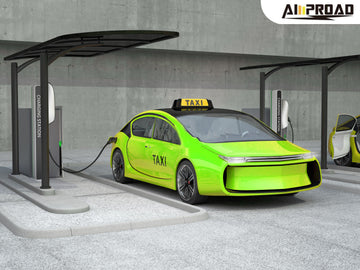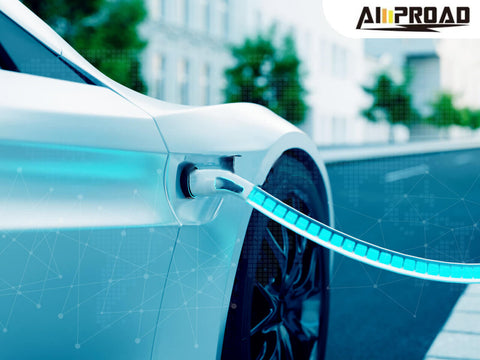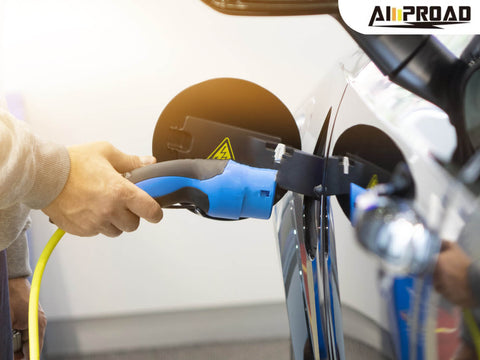
Electric vehicles are becoming more popular due to their eco-friendly nature and technological advancements. To support their widespread use, having enough places to charge them is crucial. Think of it like having gas stations for traditional cars – EVs need charging stations. A good charging infrastructure makes it easy for people to charge their EVs, making them more practical and appealing. Governments and businesses need to work together to build more charging stations so that using EVs is convenient for everyone. As more people want to use cleaner transportation, having lots of charging stations is super important for making electric vehicles a normal and easy choice.
What’s Level 1 EV Charging`?
Electric vehicles (EVs) are at the forefront of the automotive revolution, promising a greener and sustainable future. Among the various charging levels available for EVs, Level 1 charger is the most basic but essential components of the charging infrastructure. In this comprehensive exploration, we delve into the specifications, charging times, and accessibility and cost factors associated with Level 1 chargers.
Description of Level 1 Chargers
Level 1 chargers are the simplest form of electric vehicle chargers, designed for basic charging needs. These chargers operate on a standard household electrical outlet and are characterized by their basic specifications. The voltage for Level 1 chargers is typically 120 volts, mirroring the standard residential electrical supply in many countries. The current drawn is relatively low, usually around 12 amps.
The typical charging power output of Level 1 chargers is relatively modest, providing an output of around 1.4 kilowatts (kW). This makes Level 1 EV charging suitable for maintaining the charge of an EV rather than rapidly replenishing a depleted battery. While Level 1 chargers are not as fast as higher-level chargers, they serve a crucial role in specific usage scenarios.
Charging Time for Level 1 Chargers
One of the defining characteristics of Level 1 chargers is their slower charging time compared to higher-level counterparts. The charging time is influenced by the lower power output and is generally suitable for scenarios where extended charging periods are acceptable.
Charging an electric vehicle with a Level 1 charger is a gradual process. For example, a Level 1 EV charger may add around 4-6 miles of range per hour of charging, depending on the specific EV model and its battery capacity. This makes Level 1 chargers most appropriate for situations where the vehicle can be left plugged in for an extended period, such as overnight charging at home.
The extended charging time associated with Level 1 chargers is not well-suited for on-the-go charging or situations where a quick turnaround is required. However, it aligns perfectly with the usage patterns of many EV owners who primarily charge their vehicles overnight while they are parked at home.

Accessibility and Cost of Level 1 Chargers
One of the key advantages of Level 1 chargers is their widespread availability in residential settings. Since they utilize standard household outlets, Level 1 charging infrastructure is already in place in most homes, requiring no additional installations. This accessibility contributes significantly to the convenience of EV ownership, as users can easily charge their vehicles at home without the need for dedicated charging stations.
Furthermore, the cost of Level 1 charging is relatively low compared to higher-level charging infrastructure. The chargers themselves are often included with the purchase of an electric vehicle, and the only additional cost may be related to any necessary electrical upgrades. Given that Level 1 chargers leverage existing residential electrical infrastructure, the installation cost is minimal compared to the more complex setups required for higher-level chargers.
The ease of installation and lower cost make Level 1 chargers an attractive option for individuals who primarily use their EVs for daily commuting and have the ability to charge their vehicles at home. While Level 1 charging may not be the fastest option, it offers a practical and affordable solution for many electric vehicle owners, contributing to the widespread adoption of EVs.
What Is Level 2 EV Charging?
Electric vehicles (EVs) continue to shape the future of transportation, and within the realm of charging infrastructure, Level 2 chargers emerge as a pivotal and more powerful solution. In this exploration, we delve into the characteristics, charging times, accessibility, and costs associated with Level 2 chargers, providing insights into their role in advancing the electric vehicle ecosystem.
Description of Level 2 Chargers
Level 2 chargers represent a significant step up from their Level 1 counterparts in terms of charging power and efficiency. These chargers operate at a higher voltage and current, typically delivering 240 volts and currents ranging from 16 to 40 amps. The increased power output translates to a more rapid charging experience, making Level 2 charger a preferred choice for various applications.
The charging power output of Level 2 chargers is notably higher than that of Level 1, ranging from 3.3 to 19.2 kilowatts (kW). This substantial increase in power enables a faster and more efficient charging process, addressing the need for quicker turnaround times and accommodating a broader range of usage scenarios.
Charging Time for Level 2 Chargers
The standout feature of Level 2 chargers is their significantly faster charging times compared to Level 1. The enhanced power output allows Level 2 chargers to add approximately 10-60 miles of range per hour of charging, depending on the specific charger and EV model. This makes Level 2 charging ideal for situations where users require a quicker replenishment of their EV's battery.
Level 2 EV charger find practical application in various scenarios, including workplace charging and public charging stations. The faster charging times cater to the needs of individuals who may not have the luxury of leaving their vehicles plugged in for extended periods, making Level 2 charging suitable for busy professionals and those on the move.
Amproad, a notable Level 2 charger supplier, has played a crucial role in advancing the accessibility and reliability of Level 2 charging solutions. Their commitment to providing quality charging infrastructure contributes to the overall growth of electric vehicle adoption. Amproad's offerings include user-friendly and efficient Level 2 chargers, contributing to the development of a robust charging network.

Accessibility and Cost of Level 2 Chargers
Level 2 chargers are increasingly becoming available in public spaces and commercial areas, contributing to the broader accessibility of EV charging infrastructure. Public charging networks, shopping centers, and workplace parking lots are examples of locations where Level 2 chargers are commonly found. The growing presence of Level 2 charging stations in such areas enhances the convenience of EV ownership, allowing users to top up their batteries while engaged in daily activities.
However, it's essential to note that the installation of Level 2 chargers may come with higher costs and potential challenges compared to Level 1. The increased power requirements and more sophisticated infrastructure needed for Level 2 charging can result in higher installation costs. Additionally, businesses and municipalities may face challenges in retrofitting existing spaces to accommodate Level 2 charging stations. Despite these considerations, the benefits of faster charging and the broader availability of Level 2 chargers contribute to their increasing prominence in the electric vehicle landscape.
Comparison Between Level 1 and Level 2 EV Chargers
As electric vehicles (EVs) continue to reshape the automotive landscape, understanding the differences between Level 1 and Level 2 chargers becomes crucial for both current and prospective EV owners. This comparison explores charging speed, use cases, and cost considerations to provide a comprehensive overview of these two essential components of the EV charging infrastructure.
Charging Speed and Efficiency
The primary distinction between Level 1 and Level 2 chargers lies in their charging speed and efficiency. Level 2 chargers, operating at higher voltage and current, offer significantly faster charging times compared to their Level 1 counterparts. While Level 1 chargers typically add around 4-6 miles of range per hour of charging, Level 2 electric vehicle charger can add approximately 10-60 miles of range per hour, depending on the specific charger and EV model.
This increased charging speed makes Level 2 chargers more suitable for scenarios where users require a quicker turnaround time. Level 1 chargers, on the other hand, are best suited for overnight charging situations, making them ideal for residential use where the vehicle can be left plugged in for extended periods.
Use Cases and Scenarios

The choice between Level 1 and Level 2 chargers depends largely on the intended use cases and scenarios. Level 1 chargers are well-suited for residential settings, catering to basic charging needs. Homeowners can conveniently plug in their EVs overnight, ensuring a fully charged battery by morning. This aligns with the typical usage pattern of daily commuting and the ability to charge the vehicle during periods of inactivity.
In contrast, Level 2 fixed EV charger and portable EV charger near me are designed for more diverse usage scenarios. Their faster charging times make them suitable for on-the-go charging, addressing the needs of users who may not have the luxury of leaving their vehicles plugged in for extended periods. Level 2 chargers find practical application in workplace charging stations, public charging networks, and commercial areas, providing a convenient solution for individuals with busy lifestyles.
Amproad, a notable Level 2 home EVSE charger supplier, contributes to the versatility of Level 2 charging solutions. Their commitment to providing efficient and user-friendly chargers enhances the accessibility of Level 2 charging, further expanding its applicability in various usage scenarios.
Cost Considerations
Cost considerations play a significant role in the decision-making process between Level 1 and Level 2 chargers. Generally, Level 1 chargers are more affordable both in terms of the chargers themselves and the associated installation costs. Luckily, the Manufacture like Amproad provides 90-250v EV home charger, which can be used as both level 1 and level 2 EV charger. Since Level 1 chargers leverage existing residential electrical infrastructure, there is minimal need for additional investments in electrical upgrades or complex installations.
On the other hand, Level 2 chargers may incur higher upfront costs. The increased power requirements and the need for more sophisticated infrastructure can contribute to a higher installation cost. However, it's important to consider the long-term benefits. While Level 2 chargers have higher upfront costs, their faster charging times and broader range of applications may justify the investment, especially for users with more demanding charging needs.


